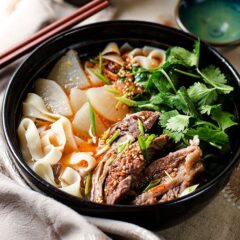
Lanzhou Beef Noodles (兰州拉面)
With a bite of the springy hand-pulled noodles, the melt-in-your-mouth beef, a bit of homemade fresh chili oil, and a sip of the rich broth, you can’t help but wonder about the magical power of a plain bowl of beef noodles.
Ingredients
- 1 beef leg bone about 700 grams / 25 ounces, cut into 5 to 6 parts (*see footnote 1)
- 1 kilogram (2 pounds) beef flank , untrimmed (*see footnote 2)
- 5 whole cloves
- 1 teaspoon Sichuan peppercorn
- 5 cloves garlic
- 1 thumb ginger , sliced
- 1 cup scallion , chopped (the white part)
- 5 chili pepper , dried
- 2 bay leaves
- 1 whole nutmeg seed
- 1 star anise
- 1 cinnamon stick (about 6 centimeters / 2.4 inches long)
- 1 teaspoon fennel seed
- 2 teaspoons salt (or to taste)
- 1 small daikon radish
- 2 tablespoons freshly made Chinese chili oil (or to taste)
- 6-8 servings hand-pulled noodles (or dried noodles)
Instructions
To cook the broth
- Thoroughly rinse leg bones and transfer them to a 5-liter (5-quart) dutch oven (or big pot).
- Cut the beef flank into strips that are around 8 centimeters (3 inches) wide and 12 centimeters (5 inches) long. Place them into the dutch oven.
- Add 10 cups of water to cover the bones and beef. Bring to a boil over high heat. Turn to medium low heat and continue to boil for 10 minutes. Use a ladle to skim the foam from the surface and discard it, repeating until the broth comes clean.
- Add cloves and Sichuan peppercorn into a tea infuser, and place the infuser in the dutch oven with the beef and bones. Add ginger, scallion, garlic, chili pepper, bay leaves, nutmeg, star anise, cinnamon stick and fennel seed to the pot, as well. Cover and simmer over low heat for 3 hours. Depending on the cut of beef you’re using, you may need to simmer longer, up to 4 hours.
- While the broth is simmering, prepare the daikon radish. Peel the radish and cut it into 5-millimeter thick slices. Further divide each slice into 4 quarters. 30 minutes before the broth is done, add the daikon radish slices to it.
- Check the broth every 30 minutes. During the first 2 hours, if the water is evaporating too quickly, add 1 to 2 cups boiling water to keep the beef and bones covered. You should not add any water during the final hour of simmering. The beef and radish should become very tender and the broth should turn a pale brownish yellow color. Add salt to season the broth. The broth should taste slightly salty by itself.
- Use a ladle to transfer the beef to a plate to cool off. Use a strainer ladle to pick out the bones and spices and discard them. You might find a thick layer of oil floating on top of the soup (depending on the fattiness of the beef). Use a ladle to skim the oil off according to your preference (see footnote 3).
- Boil hand pulled noodles. If you aren’t making hand pulled noodles, cook dried noodles according to instructions on the bag.
- Prepare Chinese chili oil according to this recipe. You can use one from the supermarket, but I highly recommend you cook your own at home. It takes only 5 minutes, and freshly made chili oil is full of aroma and will make the dish shine.
- Once the beef has cooled enough to handle, trim off any fat and discard it. Slice the lean part of the beef.
To assemble noodles
- Add noodles to each serving bowl, then pour in the broth. Top noodles with beef slices, a few pieces of daikon radish, and some cilantro. Serve immediately with chili oil. Add 1/2 teaspoon to 2 teaspoons of chili oil according to personal taste.
To store leftovers
- Store the beef broth and beef separate in air-tight containers in the fridge for up to 3 days or in the freezer for up to 1 month. You can use the beef broth in a stew or soup, if you like. The beef can be used in a stir-fry or salad.
Notes
- Ask the butcher to cut the beef bones lengthwise into a few parts when purchasing.
- Always use a cut that contains 30% to 40% fat. Using untrimmed cuts will generate a very tender and moist lean part after simmering. You can trim off and discard the fat before serving.
- I usually skim off as much oil as I can and save it. Some people like to serve the broth with oil on top, but I found it delicious enough without the oil. You can use the oil for stir-frying later and it will result in very delicious dishes (for example, this Mongolian beef fried rice). To store beef fat, allow the oil to cool in a small bowl at room temperature, then transfer it to an air-tight container. It can be stored in the fridge for up to 2 weeks.
Nutrition
Serving: 856g, Calories: 604kcal, Carbohydrates: 32.2g, Protein: 62.7g, Fat: 23.5g, Saturated Fat: 7.6g, Cholesterol: 121mg, Sodium: 2420mg, Potassium: 1270mg, Fiber: 3.6g, Sugar: 4g, Vitamin A: 300IU, Vitamin C: 32.2mg, Calcium: 70mg, Iron: 5mg